As is already well known, the Bitcoin protocol is suited for one simple thing, that are transactions and moving coins around. It has a maximum cap of 21M coins, and a system that involves miners writing transactions, nodes reading data, developers and users submitting transaction requests to miners. The system design has successfully endured the test of time and has been very successful till now.
What Bitcoin doesn’t have, and that is by design, are smart contracts and all the other things coming with it, enabling DeFi, tokens, NFTs, etc.
With the rise of the smart contract chains like Ethereum, Solana etc. and the introduction of DeFi a demand for a Bitcoin token representation on these chains has emerged. This demand comes from the need of simple trading Bitcoin on chain, to the more complicated stuff like lending using BTC as collateral and more.
In the last period we are seeing a new trend introducing Bitcoin yielding tokens, where the wrapped version of Bitcoin is a yield bearing token similar like the staked ETH tokens, stETH or Solana JitoSOL.

The most important thing to have in mind about these Bitcoin derivatives is that they are not actual Bitcoin. A token on the Ethereum network or any other network is not Bitcoin. It is a representation of Bitcoin with a promise to keep a 1:1 value. Usually, the way this works is some entity is establishing a vault on the Bitcoin chain where they keep the native Bitcoin and for every Bitcoin put in that vault/s they mint the wrapper on the other chain. It’s basically a service provided by a third party and it has an inherent additional risk from the third party.
With this said lets take a look at the tokens list. Here it is:
- WBTC
- BTCB
- cbBTC
- LBTC
- SolvBTC
- eBTC
- tBTC
There are more but these are the biggest one and represent most of the industry.
WBTC
WBTC is a wrapped Bitcoin on the Ethereum network. How does this work? Well, there is a centralized entity, a company that users send Bitcoin to, they locked into a wallet and mint WBTC on the Ethereum network. Because crypto is transparent, users can see both of the wallets for the native BTC on the Bitcoin network and WBTC on the Ethereum network at any time and make sure the balances matches.
WBTC allows users to use Bitcoin in defi protocols like AAVE and MakerDAO. In most cases WBTC is provided as collateral and then users borrow against it. It’s a beautiful thing as long as you manage your position and don’t overleverage and get liquidated. The company that was managing WBTC up until last year was BitGo situated in the US. Since last year they have partnered with BitGlobal, a Honkong/Singapure company under the umbrella of Justin Sun. This has caused controversy and soon after Coinbase launched their Bitcoin wrapper cbBTC.
Here is the chart.
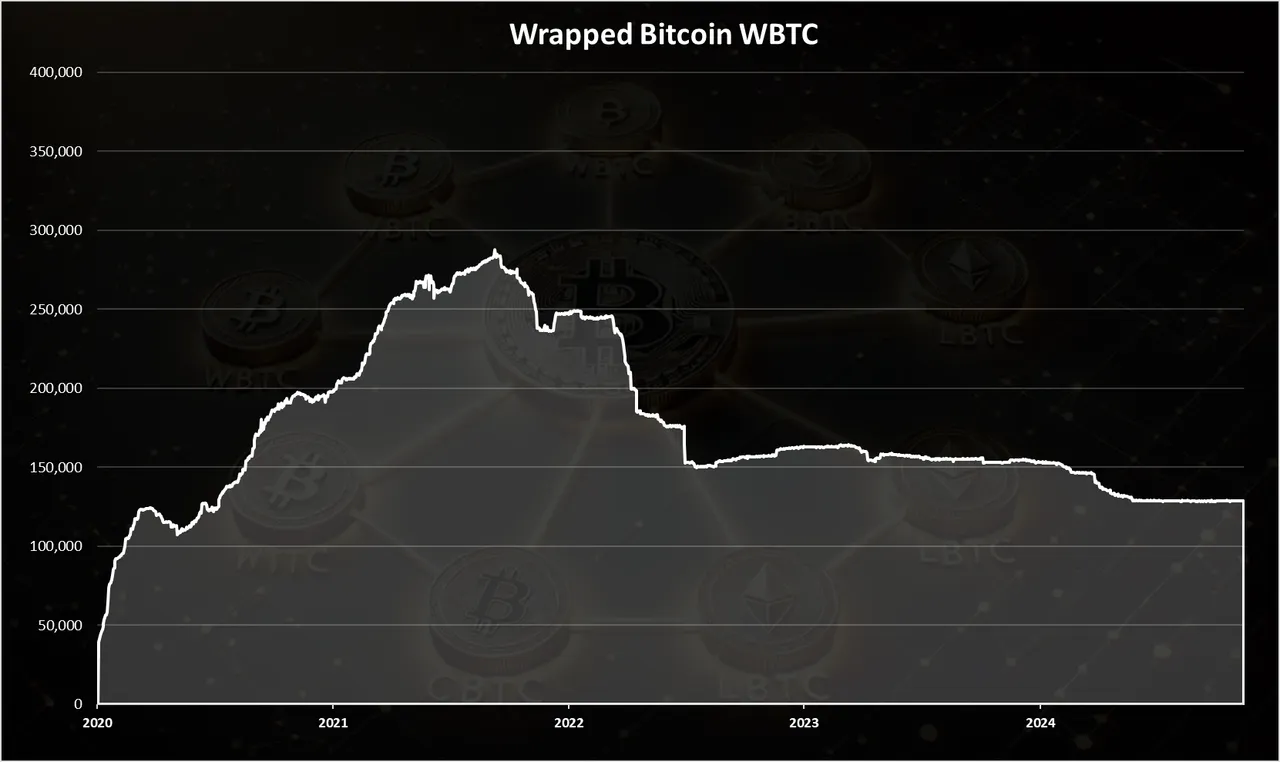
Note that the chart above is in Bitcoin dominated units, not USD. It represents how much Bitcoins are being wrapped on Ethereum.
As we can see there has been a high growth in the amount of WBTC in the previous bull run. Starting from 2020, till 2022, the amount of BTC, wrapped on ETH has kept growing and reached ATH of 285k in May 2022. At the time at those prices the market cap was around 10B. Towards the end of 2022 the amount of WBTC dropped to around 150k and has stayed around those levels up last year. Then in 2024 there was a further drop in the amount of BTC under WBTC and the numbers are now at 128k. This might be related to the rebranding and the new emerging competition for wrapped Bitcoin.
Binance BTCB
Binance has launched their version of the wrapped Bitcoin on the BSC network to be used in apps like Pancake and other DeFi applications.
The chart looks like this:
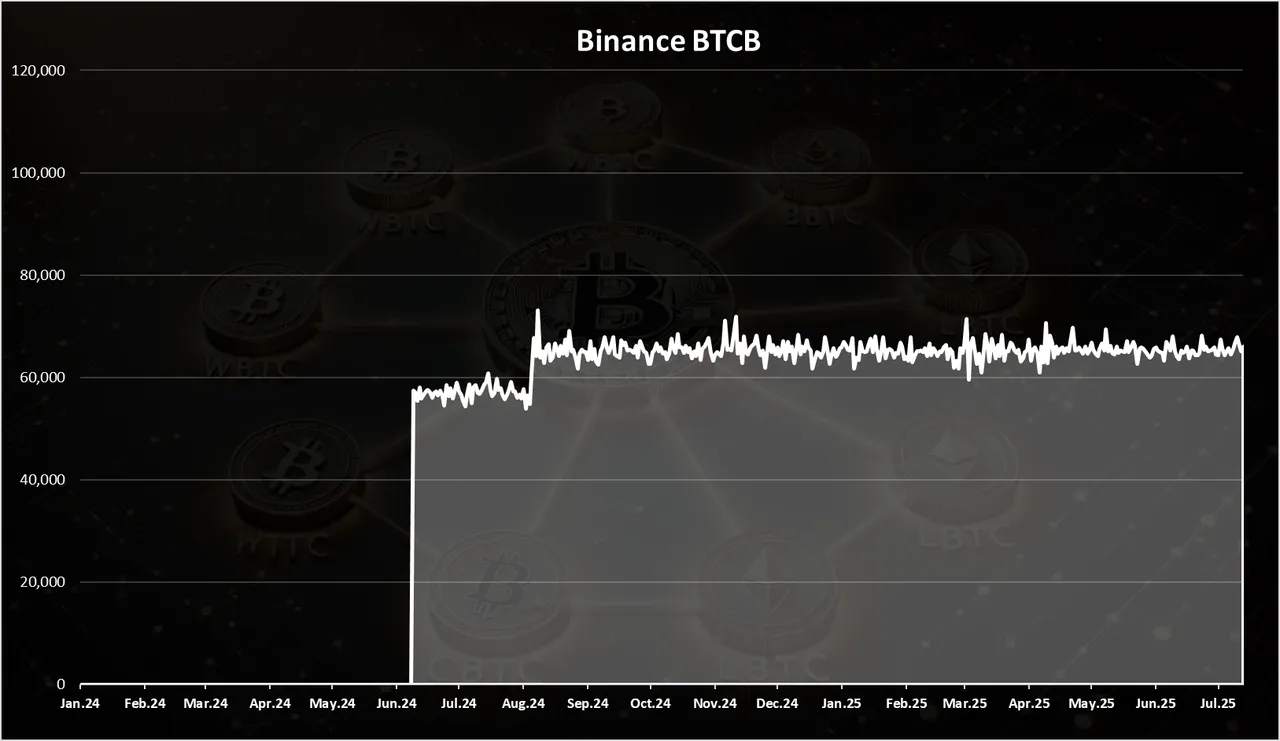
This one is a bit odd since there is no clear historical data on the BTCB, or the market cap. Plus it seems that the BTCB is pre-issued by Binance, and it represents sort of max amount of tokens, not the real in use Bitcoin on BSC. CMC shows data up until June 2024, and there is probably data prior to this date, but could found any reliable sources.
It has been around the 65k BTC mark for a year now.
Coinbase cbBTC
Following the offshore move from BitGo and the partnership with BitGlobal, Coinbase took a step forward and announced their version of wrapped Bitcoin, cbBTC, starting from September 2024. In this case the custodian for the Bitcoins is Coinbase. They are acting as a bridge between Bitcoin and the other smart contracts chains. A totally centralized solution.
Here is the chart for cbBTC:

We can see that starting from September 2024 the amount of cbBTC started growing and is constantly in an uptrend. At the moment Coinbase is custodian of 51k wrapped Bitcoin in the form of cbBTC, or around 6 billion USD. It has the heights grow rate from the top three wrapped versions of BTC.
Lombard Staked LBTC
Another version of the Bitcoin wrappers, but this time with a twist. It provides yield.
Lombard Staked BTC (LBTC) is a liquid staking token developed by Lombard, enabling Bitcoin holders to stake their BTC through the Babylon protocol while retaining liquidity for participation in decentralized finance (DeFi) applications. Each LBTC token is backed 1:1 by Bitcoin, allowing users to earn staking yields without compromising their BTC's security or value. This integration transforms Bitcoin from a static store of value into a productive asset within the DeFi ecosystem
The Babylon protocol is an L2 chain for Bitcoin that tries to bridge Bitcoin to EVM chains and DeFi.
Here is the chart for LBTC.
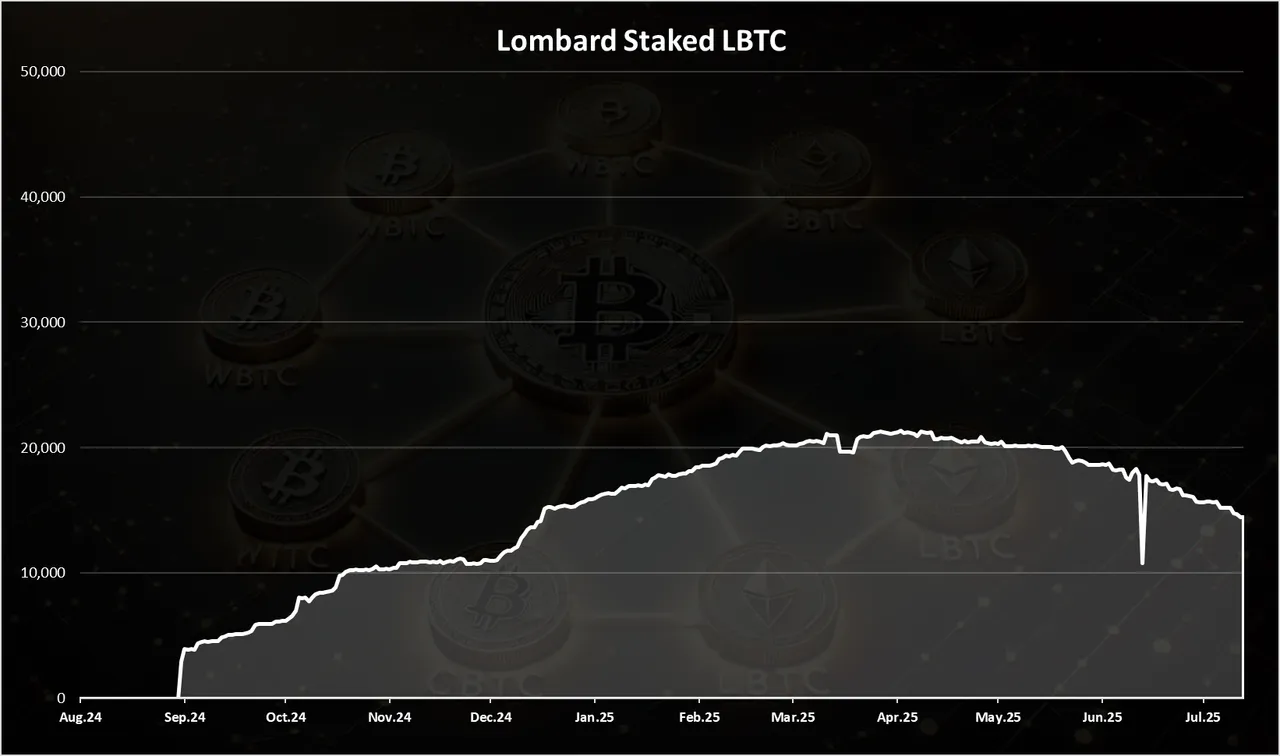
As we can see this chart had an uptrend up until recently reaching 20k BTC in April 2025.A drop since then and it is now at around 14k BTC. Still quite high number with a value in USD bigger than one billion having in mind the current BTC prices.
Cumulative Chart for the Top Bitcoin Wrappers
When we add all the above together, plus some smaller ones like eBTC, tBTC we get this chart.
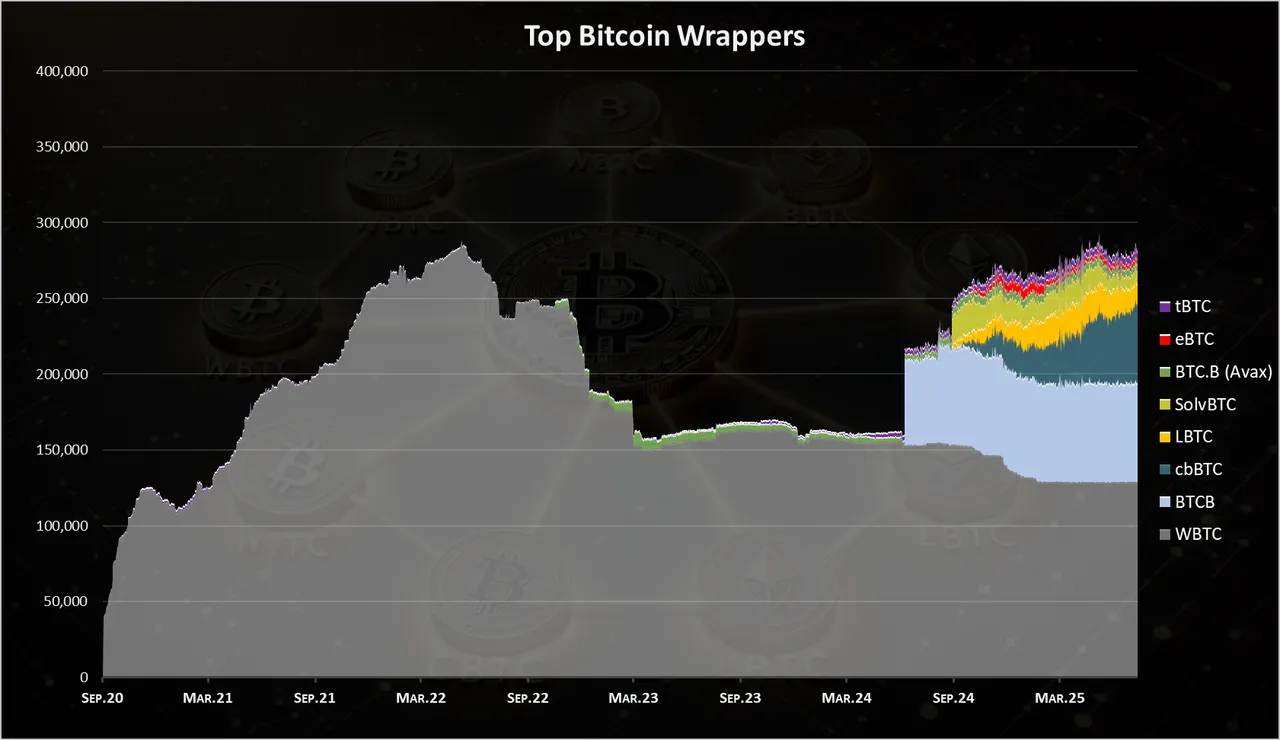
This is a long term chart, starting from 2020, when the only dominant player was WBTC. But we can see since last year, 2024 the competition has heated up significantly and more options for Bitcoin wrappers have emerged. But even with all the new options the previous ATH for Bitcoin wrappers has just now been reached. We are now at 282k BTC in these instruments, around the same spot from the previous ATH.
Coinbase cbBTC has been the main driver for the growth in the last period, the others have been somewhat stagnant.
When we zoom in, we get this:
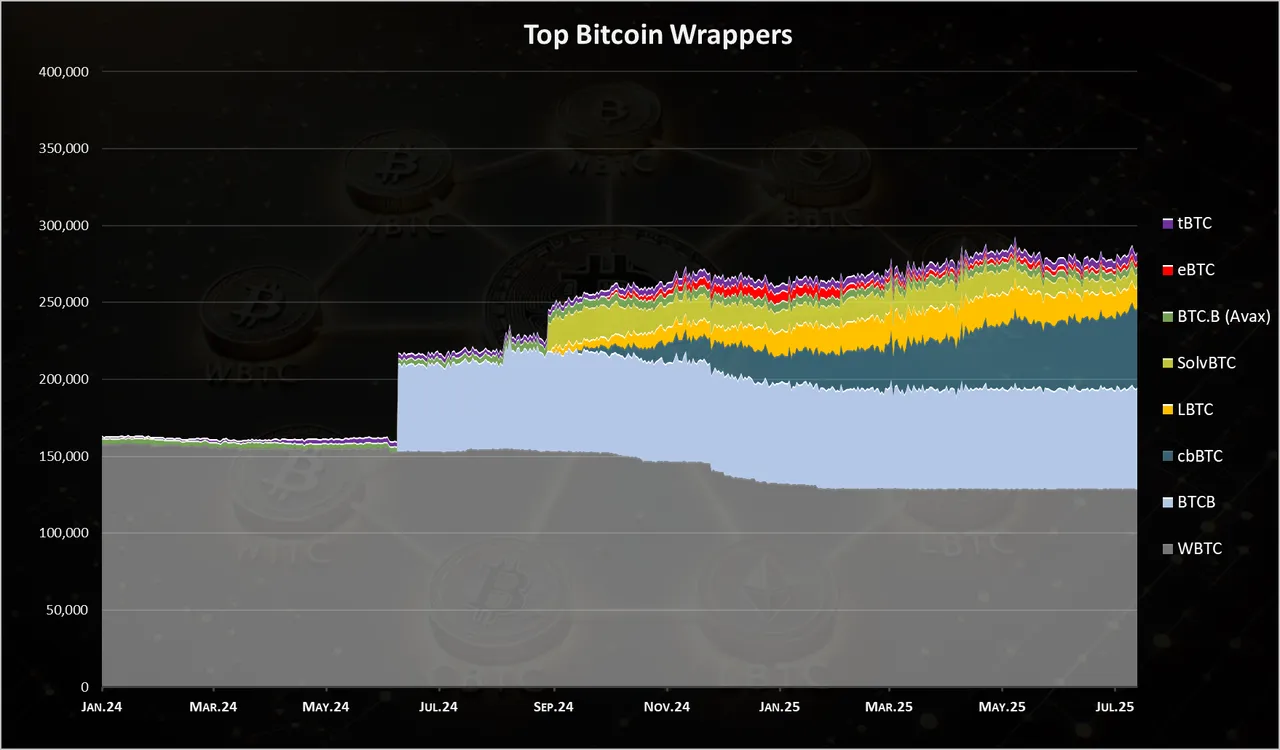
Here we can see more clearly how the WBTC dominance is going down and more other options have emerged. cbBTC is the leader of those, but LBTC some others are also significant players.
Top Bitcoin Wrappers Share
The current share of the Bitcoin wrappers looks like this.
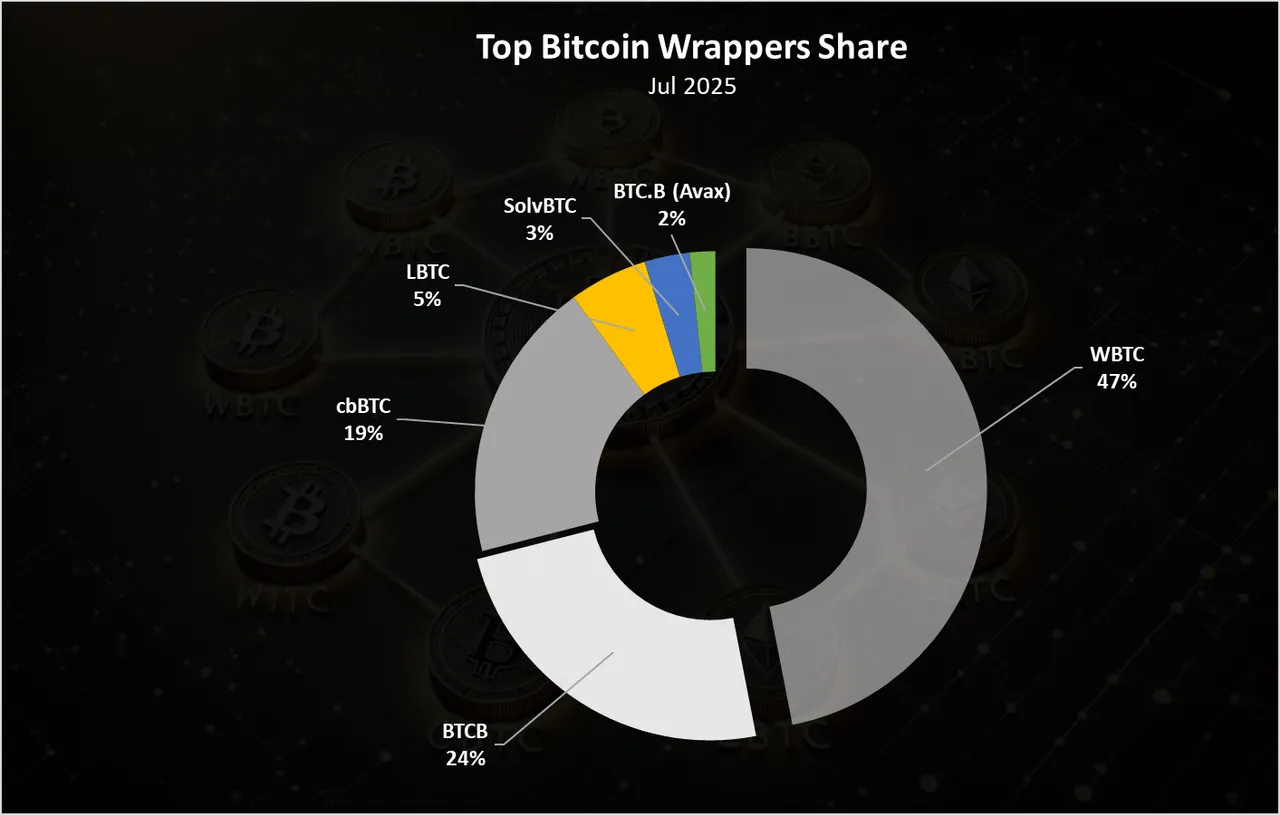
WBTC is still dominant with 47%, but far from the only dominant player where it was just a year ago. Binance BTCB is at 24%, while Coinbase cbBTC has 19% share, followed by LBTC etc.
At the end the market cap for the bitcoin wrappers in USD:
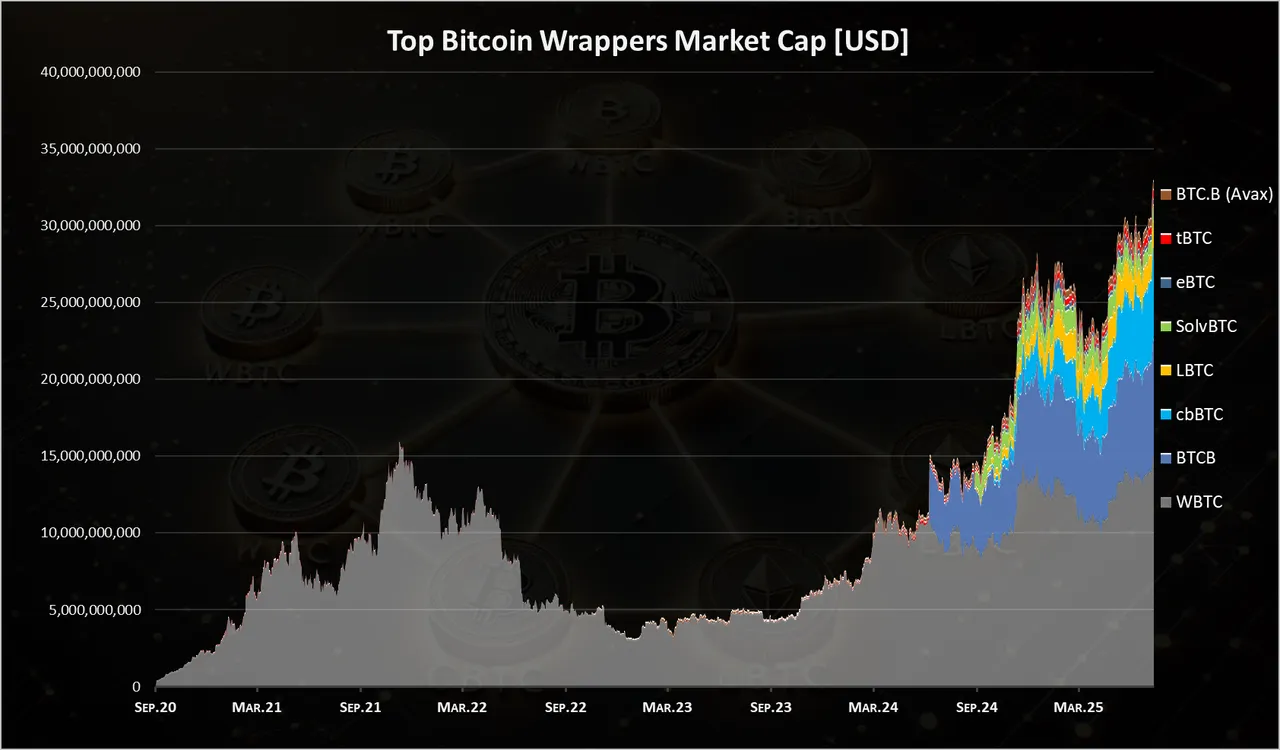
When we look in USD dollars we have now an ATH in market cap for the bitcoin wrappers with close to 30B market cap combined. The previous ATH in dollar units was around 15B. In terms of BTC we are around the same spot as in the previous market cap, but obviouslyt the price is now much higher and so does the USD market cap.
Overall, we can see that there is now more options for the Bitcoin wrappers, but in terms of Bitcoin the allocation remains somewhat stagnant with the exception of Coinbase cbBTC. The other wrappers don’t have a growth in terms of BTC. Where the growth is evident is in the USD value, where due to the increase in the price of Bitcoin, the wrappers now have 30B in market cap, double then the previous all time high.
The need for Bitcoin DeFi is obvious and users are searching for yield. This of course comes at additional risk, and everyone should be very cautious when using these products. For sure do not put all your BTC in any of them. My guess is that as time goes on, we will see more and more BTC derivatives that will try to add more functionality and financial instruments to Bitcoin.
All the best
@dalz